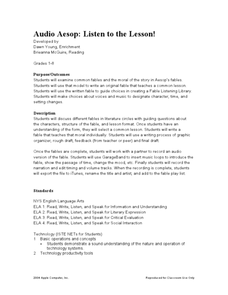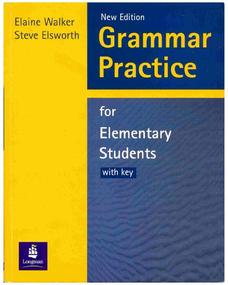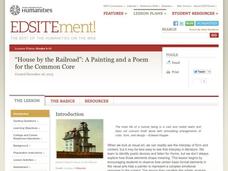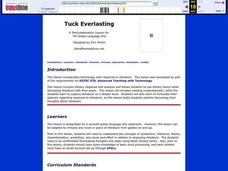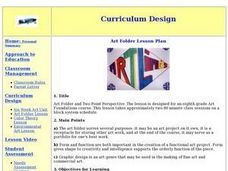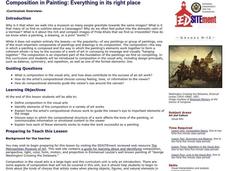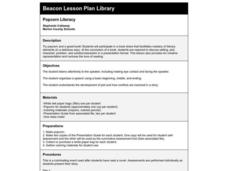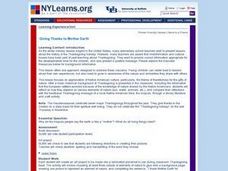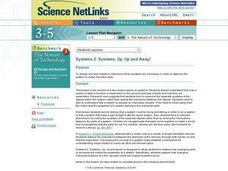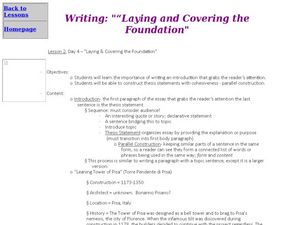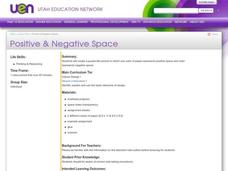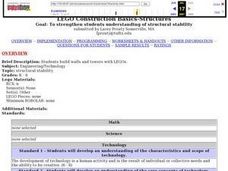Curated OER
Audio Aesop: Listen to the Lesson!
Aesop's Fables are the focus of this language arts lesson. Young philosophers study and discuss the morals found in the most famous of Aesop's Fables. They write an original fable that teaches a common moral. A "Fable Listening Library"...
Longman
Grammar Practice for Elementary Students
Designed for elementary students, this 178-page practice booklet covers all the basic elements of grammar instruction.
National Endowment for the Humanities
“House by the Railroad”: A Painting and a Poem for the Common Core
Introduce your class to ekphrastic poetry with an exercise that asks them to examine Edward Hooper's painting House by the Railroad and Edward Hirsch's poem "Edward Hopper and the House By the Railroad." After a close reading...
Curated OER
Tuck Everlasting
Seventh graders use literary terms while discussing literature with their peers. They explore literature on a deeper level. Students formulate their opinions regarding response to literature, as this lesson plan helps students practice...
Curated OER
Tony Cragg-Evidence
Students demonstrate an understanding of basic elements and principles of art making such as unity, variety, movement, and meaning found in daily experiences. They also describe the meaning of students¿ own artwork in a written statement.
Curated OER
Art Folder and Two Point Perspective
Eighth graders examine how to create a 3-D effect on a flat surface and draw in two-point perspective. They view and discuss elements of design, analyze artwork by M.C. Escher and Roy Lichtenstein, and design and create an art folder.
Curated OER
Everything in Its Right Place: an Introduction To Composition in Painting
Learners complete a variety of activities as they study the basics of artistic composition in the visual arts.
Marion County Schools
Popcorn Literacy
Popcorn is a tasty part of a culminating activity designed to motivate readers to share important literary elements. The popcorn fills the inside of a white paper bag that is transformed on the outside into a presentation tool with the...
Curated OER
Maus I and II: Pictionary
Why is visual literacy so important in understanding Maus? Introduce your class to basic elements of graphic novels with a game of pictionary. A list of 13 words are included, but you could potentially add some World War II-related...
Nazareth College
Chronological Order
First, next, and last, the elements of chronological order. In every story or text one can find a series of events that occur one after the other. To help learners with visual impairments conceptualize chronological order, this...
Curated OER
Giving Thanks to Mother Earth
Pupils create an art project to be made into a laminated placemat to use during a classroom Thanksgiving feast. The lesson involves choosing at least three cutouts of elements of nature to glue onto a background page, drawing one picture...
Curated OER
The Chemicals of Living Cells
Designed to be a study guide or self assessment for high school biologists, the worksheet has good questions about cell chemistry, but would need to be reformatted if you want your kids to write their answers on the paper. There are also...
Curated OER
Where Do I Fit In?: Mental Mapping Student Neighborhoods
Students examine geography through the themes of place, human/environment interaction, and region. They create a mental map of their own neighborhood, analyze their role in the world, and design a neighborhood that reflects their needs.
Curated OER
The Scarlet Letter
Designed as a visual outline for a lecture on the historical and literary background of The Scarlet Letter, the slides in this presentation pinpoint the themes and literary elements in the novel, the basic tenets of Puritanism, and the...
Curated OER
Systems, UP, Up and Away!
Students discuss rockets and how they work. Students research basic information about the Space Shuttle. Students work in collaborative groups creating "rockets" with empty film canisters. Students launch their "rockets" and record...
Curated OER
Writing: Laying and Covering the Foundation
Your middle schoolers can become stronger writers with a lesson covering the basics. They compose effective thesis statements and introductions, discuss different ways to capture a reader's attention, and compare a poorly written...
Curated OER
Learning Landscapes
Fifth graders analyze a landscape depicting Yosemite during the time of the Wild West. They compare their perceptions of the West from film and television to this representation. They observe the use of scale and color to depict size and...
Curated OER
Runoff: Intro to Watersheds
Students are taught that a watershed is, what types of basic land cover are impermeable and permeable to water. They trace the flow of water around their school and around their home. Students determine what watershed their school is a...
Curated OER
Introductions: Definition and Writing Tips
Using PowerShow.com, this presentation focuses on how to write basic introductions including four main points: create an opening sentence that sizzles, identify a clear, central idea, relate the topic's importance, and write a solid...
Curated OER
Positive & Negative Space
Students review and differentiate between positive and negative space, view teacher sample, and cut out shapes to create puzzle-like picture in which one color of paper represents positive space and one color represents negative space.
Curated OER
Architecture
Students use the glossary/dictionary and a partner to make flashcards of the important architectural terms and their definitions. Study them, present them to the teacher, and answer 5 correctly. This activity is part of a layered...
Curated OER
Structural Stability - Legos
Students are introduced to a variety of design elements that promote structural stability including beams, joints and pins. They demonstrate the use of these elements with Lego constructions and compare the stability of several...
Curated OER
Word Search
Students practice creating and formating a new word document. They add tables with specific rows and columns. They also include design elements in their document.
Teach Engineering
Gumdrop Atoms
There's nothing sticky about the resource, unless you count the gumdrops! Scholars create a model of a lithium atom, complete with protons, neutrons, and electrons. It's just that these models are made with gumdrops and toothpicks.
